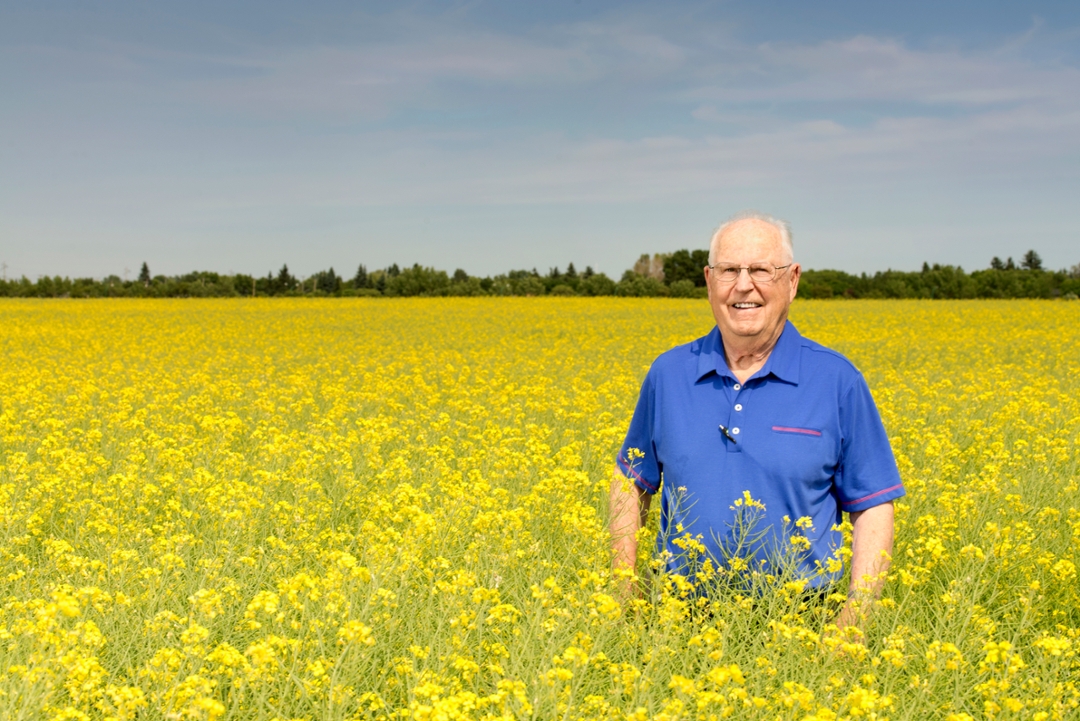
Mister Canola wears his crown lightly
Canola came of age in Saskatchewan. In the four decades since its debut, it has become the country’s major oilseed crop, exceeding wheat in acreage and value. One of the much-lauded originators of canola is Keith Downey, an alumnus of the U of S.
By dee Hobsbawn-SmithDowney had spent the summers since he’d turned fifteen caring for forage crops on Agriculture Canada plots at the U of S. Oil derived from rapeseed—needed for the war effort as a lubricant for the era’s steam-powered ships and trains—was planted by Agriculture Canada.
“I hoed and harvested and threshed [rapeseed] in the original plots we grew in the ‘40s, and later, as a university student, I took charge of plant crossing,” he recalled. “Chemistry 5 (organic chemistry) was difficult, and it was one subject I thought I’d never use, but turned out that it was one of the major areas in my career.”
Downey earned his bachelor’s and a master’s degrees at the U of S College of Agriculture and Bioresources, then a PhD at Cornell. When he came back to Saskatoon in 1957 to work as an alfalfa breeder at the research station, “They said, ‘you can also handle this little rapeseed project because you know more about it from your student days than our other scientists.’”
A few years later, Downey became senior research scientist with Agriculture Canada’s research station on campus, and an adjunct professor in the U of S College of Agriculture and Bioresources. The “little” project wasn’t really so little.
“We were modifying the fatty acid composition of rapeseed oil to eliminate undesirable fatty acids,” he said, “to make it more beneficial [as an edible oil]. The second objective was to remove the sulphur compounds to make the meal more palatable and marketable as a high-quality protein source for livestock and poultry.” Downey learned the importance of colleagues early. His associate, organic chemist Burton Craig, head of the National Research Council’s lab, pioneered the gas chromatograph used to analyze fatty acid composition in an oil. “Before that,” Downey said, “you required a pound of seed and a week’s time to make one analysis, and that was only approximate. This machine could do it in half an hour. So we built on each other’s research.” In the late 1950s, nutritionists concluded that the high erucic acid content in rapeseed was undesirable in an edible oil. Downey and Baldur Stefansson of the University of Manitoba, using Craig’s technique, discovered the first “zero” erucic rapeseed in 1960 that led to the evolution of canola from rapeseed. Downey released the first low erucic varieties of both species in 1968 and 1971. Downey’s first graduate student was Bryan Harvey, and together they developed a technique of splitting a seed and analyzing the oil from half of it, then—if it met their criteria—they germinated and grew the remaining half, thus saving a year in the plant-breeding cycle. Now called the “half-seed” technique, the process has been adopted worldwide for a variety of plant species. Rapeseed research ultimately resulted in the elimination of sulphur compounds called glucosinolates, then led to the combination of the zero erucic and low glucosinolate characteristics in high-yielding varieties in Downey’s and Stefansson’s labs. The two breakthroughs were opening gambits in the chess game of developing canola, the familiar yellow-flowered crop that has now brightens fields across the prairies. Ensuing breeding by Downey and Stefansson led to release of the first“double low” Argentine variety, Tower, in 1974 and the first double low Polish variety from Downey’s program in 1977. The improved seed, oil and meal from these and future varieties became known as canola (a hybrid of “Canada” and “oil”). The two men are now considered the fathers of canola. Downey has been recognized with countless accolades, including the Order of Canada. As an adjunct professor, he supervised dozens of graduate students, and the research work of an equal number of visiting scholars from developing countries. He taught the scientific method to thousands of school-age children in an ingenious two-year “space seed” program, observing seeds that had gone into orbit on the space shuttle Columbia. During his 40-year career with Agriculture and Agri-Food Canada, Downey was involved in developing 13 canola varieties, five condiment mustards and a winter-hardy alfalfa, while sharing his expertise globally. More recently, Downey and his late wife endowed a plant sciences grad student award at the U of S. “I want to support science and advancement, and the education of young people,” he said. “My five children all graduated from the U of S and the education and training they received has been a large factor in the success they have achieved.” What makes the scientific achievement of canola so notable? In 2017, twenty-two million acres were seeded to canola across Canada, and it is now the heart-smart source of ninety per cent of Canada’s domestically produced salad and cooking oils, with a fatty acid profile similar to its ancient rival, olive oil; according to Downey, canola is “more important than olive oil.”
Downey is 90 this year, still vital, happily picking raspberries in his daughter’s small-town Alberta garden. He is still involved in what he started, serving as a brain trust for the annual Canola Industry Day in Saskatoon, a meeting for scientists, technicians and people who deal with the farming public.
“The speed with which science is moving forward is outpacing our ability to keep the public informed,” he said. “The misinformation out there is scary. Scientists should continue to forge ahead, but figure out how to get people interested in what you are doing, to understand how you are changing things to make life better for all of us.”

